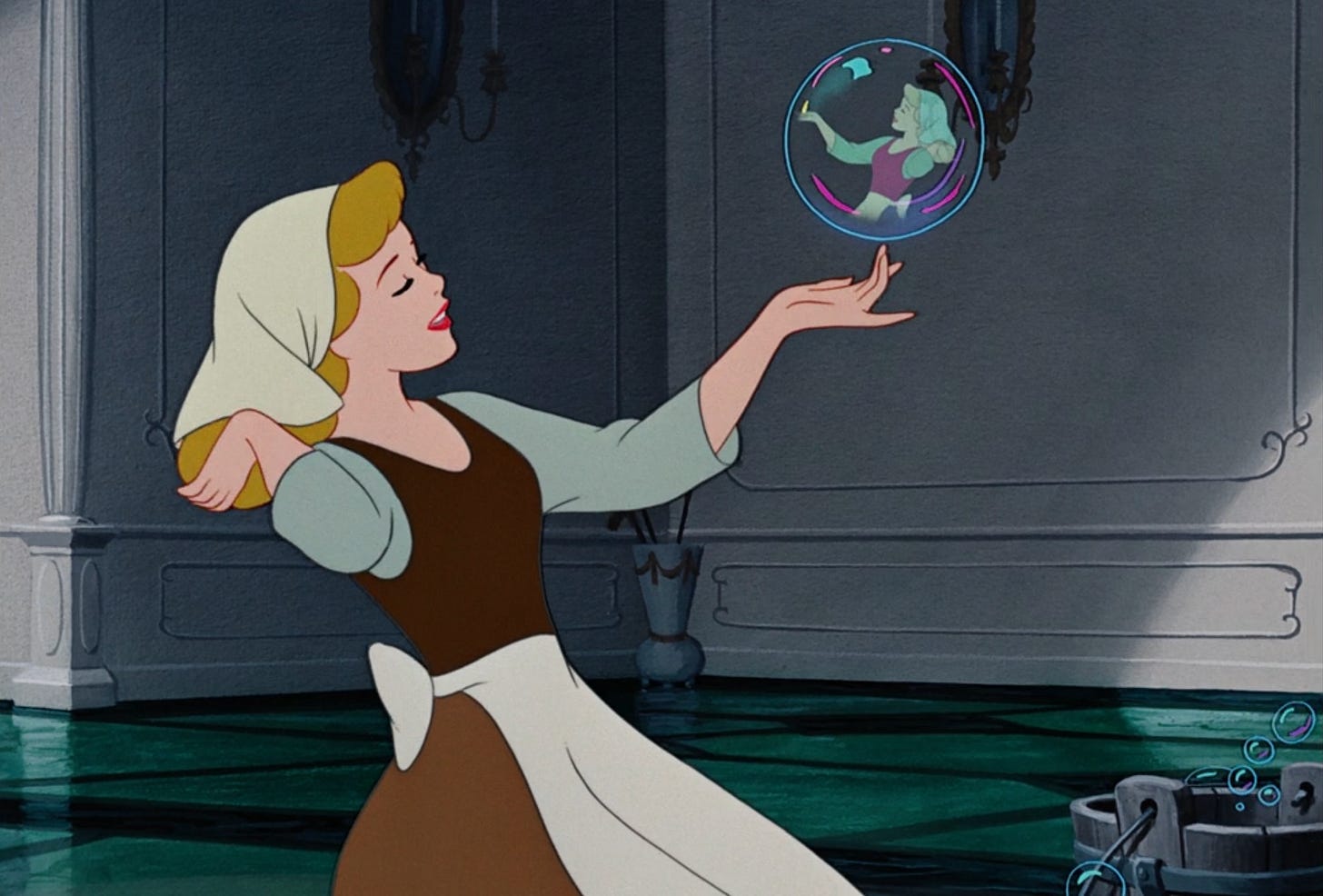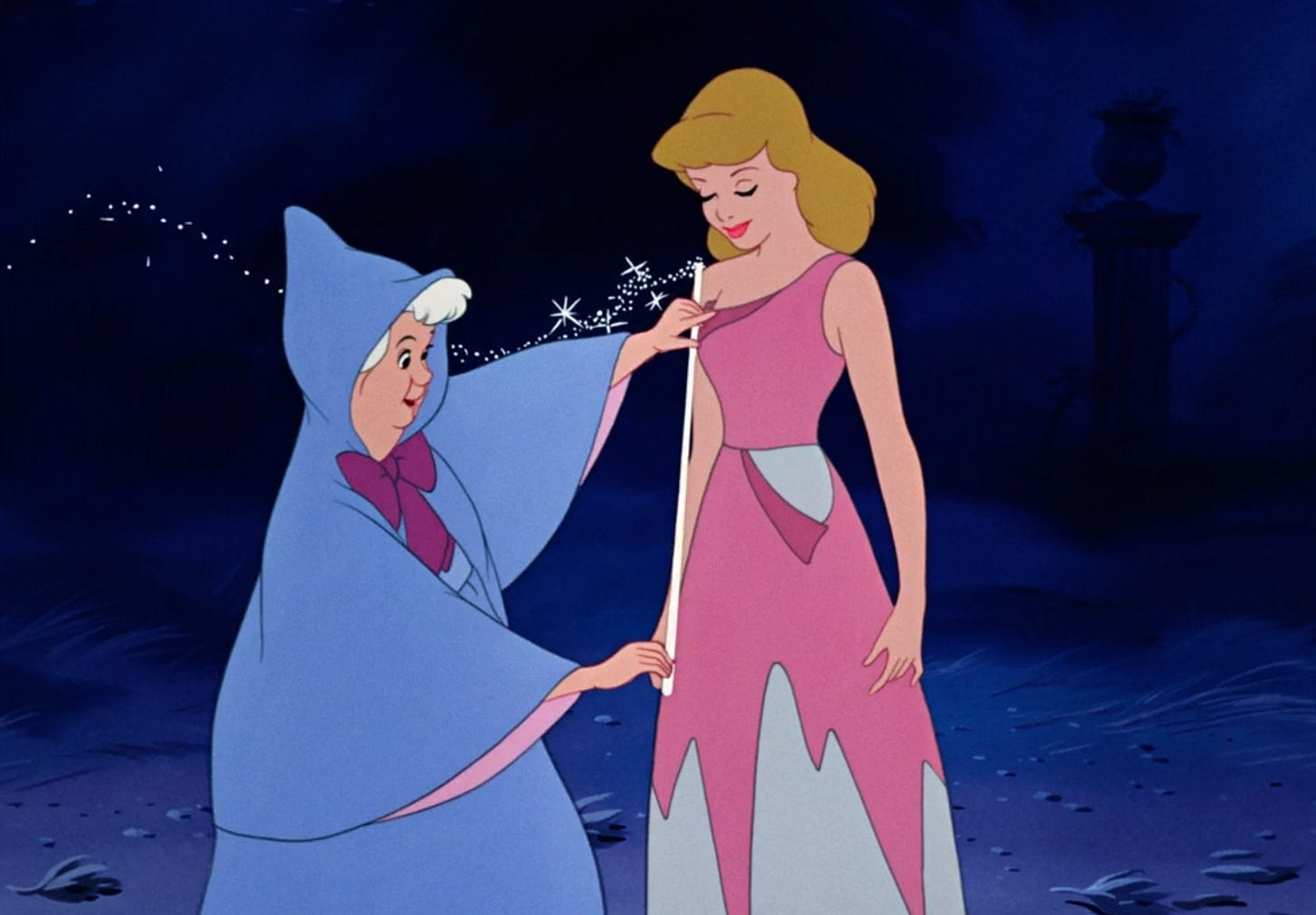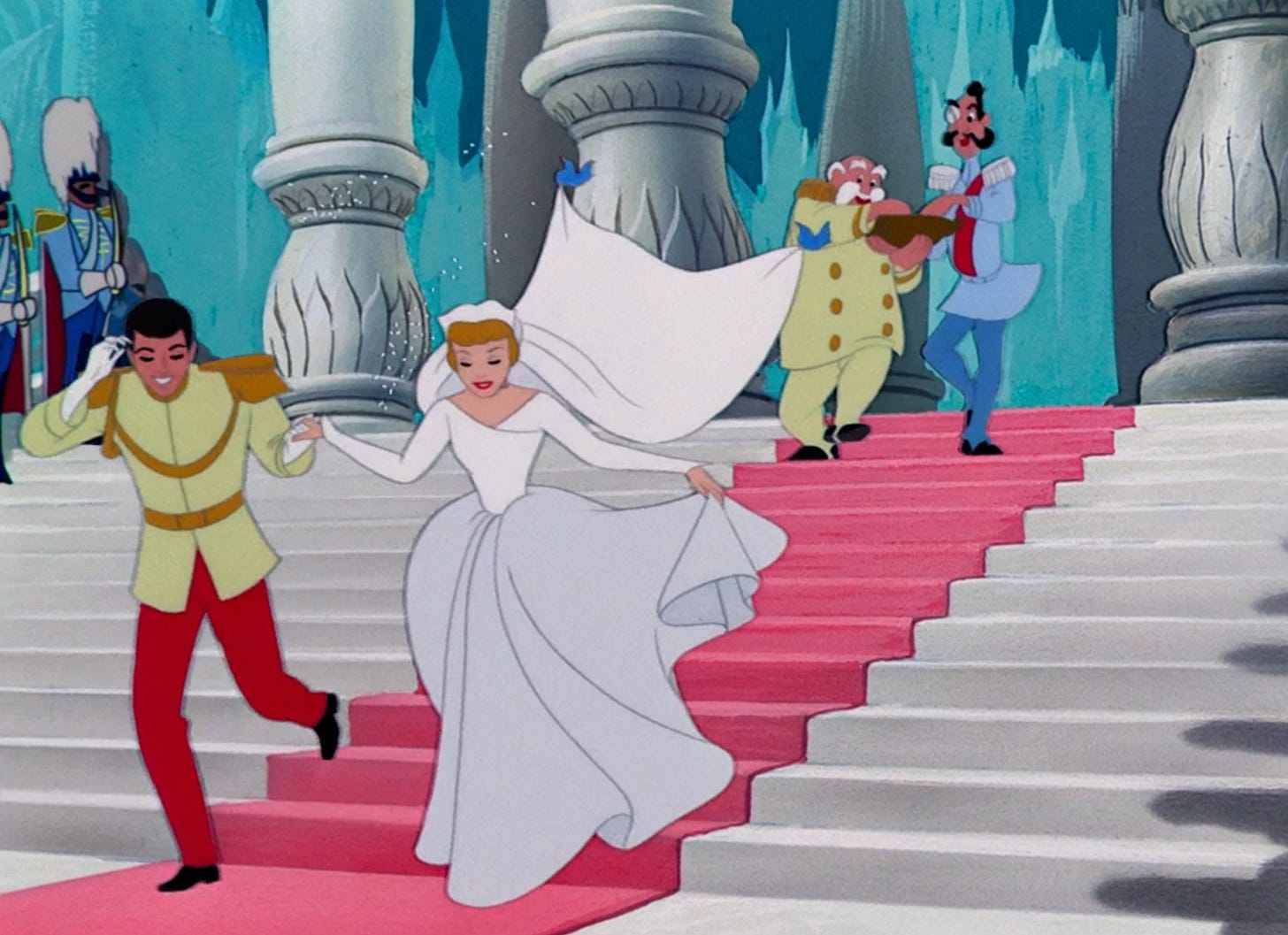The Princess Diaries #2: Cinderella (1950)
Over a decade after Snow White, Disney revitalized itself with another princess who’s less passive than she seems
Welcome to Girl Culture, the newsletter where Caroline Siede examines pop culture, feminism, and more. You can learn about Girl Culture’s mission here and support here.
One of the funny things about Disney princess branding is how it flattens their films in time. Even if you know that some princesses are older than others, you might not realize that Disney’s first and second princesses debuted 13 years and one world war apart. Though Disney pioneered feature-length animation with 1937’s Snow White and the Seven Dwarfs, the company swiftly moved on to male protagonists in Pinocchio, Dumbo, and Bambi. (And Fantasia, if we can consider Mickey a protagonist there.)
Though Disney’s early features are now considered classics, most of them struggled to turn a profit as World War II cut off the overseas market. In fact, Disney sort of lost its identity during the mid 1940s, as it shifted to making quick, cheap anthology movies called “package films.” (Think The Three Caballeros and The Adventures of Ichabod and Mr. Toad.) The studio was in debt and without a real identity anymore. So with a new decade on the horizon, Walt Disney wanted a reset. He decided to return to the fairy tale princess wishing well that had launched the studio in the first place. This time they would adapt Charles Perrault’s take on the classic Cinderella folk tale.
Released February 15, 1950, Cinderella became the studio’s biggest critical and commercial hit since Snow White. It helped rewrite the studio’s fortunes and pave the way for other beloved 1950s features like Alice in Wonderland, Peter Pan, Lady and the Tramp, and the other pre-Renaissance Disney princess, Sleeping Beauty. On her own, Snow White could have just been a one-off fairy tale heroine. But with the success of Cinderella, the very idea of the “Disney princess” archetype was born.
In fact, I’d argue that Cinderella is the definitive Disney princess—the one who gets the big castle at Disney World and the one who set the template for fairy godmothers and talking animal sidekicks. When you think princess magic, you think “Bibbidi-Bobbidi-Boo.” And the image of a glass slipper on a pillow is as tied to Disney’s branding as Mickey Mouse or Tinker Bell—which is funny because she’s also the princess who has the most iconic reimaginings outside of Disney as well, from the Rodgers and Hammerstein musical to Into the Wood to Ella Enchanted to that Camila Cabello version I didn’t totally hate.
Though the “classic” princesses weren’t in particularly regular rotation in my house as a kid, Cinderella is by far my favorite of the three. I’m absolutely obsessed with the movie’s animation style, maybe because the 1950s is one of my favorite decades for film and it’s fun to see that era’s filmmaking style rendered in 2D. The Mary Blair-inspired watercolor backdrops make for a gorgeous contrast with character animation that’s so soft and round and gentle it feels like there’s barely a straight line in the film. Even now, watching Cinderella unbraid her softly drawn hair or step into her perfectly rounded flats fills me with that same kind of joy I used to get playing with Barbie dolls.
I also love all the attention to detail in how Cinderella lives her daily life, from how her bird friends tie up her apron to how she balances breakfast trays on her head to the gorgeous “Sing, Sweet Nightingale” number where the bubbles from her cleaning bucket become a choir of voices. On this viewing, the “A Dream Is a Wish Your Heart Makes” opening sequence really reminded me of all the quirky details crammed into Gene Kelly’s flat in An American in Paris, which came out the next year. Only, of course, no one watches An American in Paris and wrings their hands about whether or not Kelly’s character is a good role model for little boys.
As I wrote about in my piece on the Snow White remake, I find the whole idea that Disney princesses are supposed to be role models to be kind of dumb and not at all how I engaged with these films as a little girl raised on them. But since that is how a lot of people engage with these stories, I think it’s worth coming to Cindy’s defense too. The classic critique of this version of Cinderella is that she’s yet another passive princess waiting around to be rescued by a man. But that’s not really how the story plays out onscreen—especially considering the prince doesn’t even appear until 48 minutes into this 76-minute film.
If Cinderella has a central theme, it’s about Cinderella’s emotional resilience in the face of familial abuse. Though she’s horribly mistreated by her terrifyingly icy stepmother Lady Tremaine and her oafish stepsisters Drizella and Anastasia, Cinderella breaks that cycle of abuse when it comes to dealing with those who have less power than her. She saves mice from traps and dresses them up as her friends (a delightfully demented touch). And she won’t even let the family dog Bruno abuse her stepmom’s cat Lucifer—even though that little bastard absolutely has it coming.
Cinderella can’t “save herself” physically because she’s an aristocratic woman in the 19th century and there weren’t really options for just moving out and starting your own life. But she can save herself mentally by refusing to give into negative, pessimistic thinking and instead holding on to the hope that her life will get better one day. She literally sings: “No matter how your heart is grieving / If you keep on believing / The dream that you wish will come true.” Or, as she puts it after lamenting how everyone orders her around all day, “Well, there’s one thing—they can’t order me to stop dreaming.”
I also think people mistake Cinderella’s kindness for passivity, even though those are actually two very different things (something Kenneth Branagh’s gentle 2015 live action remake really tries to highlight). Cinderella isn’t in open daily rebellion against her stepfamily because there’s really nothing to be gained from that. But when an invite to a royal ball arrives, she doesn’t mince words about what she wants. “Why, that means I can go too!” she exclaims after they read out the details of the invitation. When her stepsisters make fun of her for thinking above her station, she shoots back, “Well, why not? After all, I’m still a member of the family. And it says, ‘by royal command, every eligible maiden is to attend.’”
As with Snow White, there’s a little more sass and creativity to Cinderella than people give her credit for. She even sets about designing her own dress to wear to the event—the peak of active ingenuity, if you ask me. And while it’s her mice friends who finish the gown while her family keeps her too busy to get ready, that’s only because Cinderella has made bespoke outfits for all of them first and they want to do something nice in return. As with the cleaning and pie-making in Snow White, I find the sewing “Work Song” sequence in Cinderella glorious to watch because it’s the sort of domestic task you don’t usually see celebrated in animation.
After seeing how much work the animals put into Cinderella’s bubble gum pink gown, it’s harrowing to watch the stepsisters literally rip it to shreds. While Cinderella mostly keeps things on the lighter side of the Disney spectrum, the attack scene captures violent familial abuse in action. It’s also the first moment that truly breaks Cinderella’s spirit and reduces her to tears of doubt. (“There’s nothing left to believe in.”) That’s when her faith literally manifests as a fairy tale solution to her problems; a fairy godmother who gives her a picture-perfect few hours with a strict deadline—and another amazing evening gown.
Walt cited Cinderella’s dress transformation as his favorite bit of animation the studio ever produced and it really is glorious in its sparkly silver simplicity. The fairy godmother sequence only lasts about five minutes, but it’s remarkable how influential it feels on the visual language of not just Disney but also every other fairy tale adaptation that came in its wake. Disney had experimented with the fairy godmother archetype with the Blue Fairy in Pinocchio, but really locks into its version of the trope here.
Indeed, if there’s anything jarring about Cinderella, it’s that—as with Snow White—Disney hadn’t quite yet figured out how to blend everyday human stories with epic fairy tale ones yet. Most of the film hinges on light observational humor, with Lucifer and the mice Jaq and Gus (two absolute icons) providing Tom and Jerry antics to fulfill the animated comedy quota. But the ball sequence switches to the operatic tradition of love at first sight, where you kind of just have to buy that Cinderella and the prince can fall for each other over a single montage. (It’s interesting how much the “So This Is Love” sequence feels like a first draft for the much more robust love story Disney would deliver in Lady and the Tramp five years later.)
Crucially, however, Cinderella doesn’t go to the ball to meet the prince—she literally just wants a night out of the house. And she falls for him without realizing who he is. True, he doesn’t have much of a personality (that all goes to his portly little dad who’s obsessed with having grandkids), but, again, I kind of love the way these early princess movies assume handsome straight men are too boring to waste screentime on. (It’s like how female love interests are treated in superhero stories.) Why spend time on the prince’s psyche when there are bitchy women and cute mice to hang out with instead?
Indeed, if there’s anything you need to warn your daughters about after you show them this movie, it’s that real-life rodents will probably be a little less helpful in a crisis than the ones in this film. If anyone is saving Cinderella in the end, it’s the mice not the prince. But she does take on a much more emotionally active role in the film’s final few minutes, after she realizes she was dancing with royalty and he’s now out looking for her. For the first time Cinderella does have a chance to physically rescue herself from her abusive household. So when her stepmom locks her in her room, she calls in whatever animal reinforcements she can to help break her out.
It's the kind of “action” climax that Disney would continue to grow and iterate on in its subsequent princess films. I particularly love the cheeky moment where Cinderella pulls the other glass slipper out of her pocket after her stepmom smashes the one the Duke has been testing out on young women. And after Snow White ended with its central couple riding off into the sunset, Cinderella set the template of princess flicks ending with a wedding—something Disney has alternately embraced and stepped away from over the years.
It's also worth pointing out that while Snow White gave us two iconic female characters in Snow and the Evil Queen, Cinderella gives us five: Cinderella, Lady Tremaine, Drizella, Anastasia, and the fairy godmother—all of whom have distinct looks and personalities. I’d challenge you to think through your favorite films and figure out how many of them have five separate female characters you could instantly recognize as a Halloween costume or theme park performer. It’s far rarer than you think, even in the Disney canon.
If part of the power of representation is providing a shared cultural reference point, 1950’s Cinderella did just that, all while delivering some truly gorgeous animation. So while there are more nuanced takes on the Cinderella story out there—including my beloved Ever After—the Disney version holds a special place in my heart too. It’s a story where the emotional lives of women (and mice) are center stage. And that’s something that still feels as revolutionary now as it did in 1950.
Next time: Sleeping Beauty brought the Disney princess archetype to epic new heights.












this series is healing me after all of the extremely bad takes over the years
This is a really wonderful piece. Will you be covering Ariel? She’s been done dirty and needs defending! She’s a secret feminist icon!